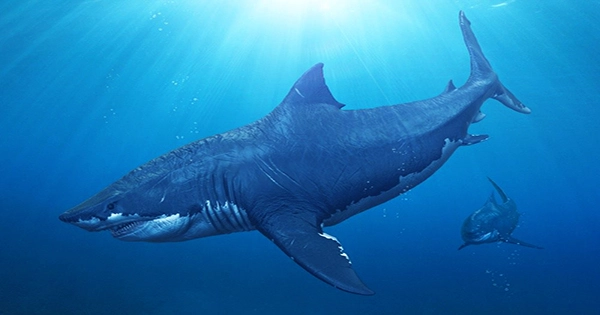The deadly megalodon of Earth is a favourite monster in Hollywood science fiction, but recent research claims that we have no idea what these creatures looked like. Otodus megalodon, which is sometimes represented as a monstrous shark, may have resembled extant great white sharks in body layout, however all of these estimates are based on supposition. Previous studies have attempted to estimate the true size of the gigantic megalodon by combining data from its descendants, such as the mako, salmon, and porbeagle sharks, as well as the great white shark. They were then able to match these details to the megalodon remnants that we still have today: their massive gnashers.
They estimated megalodon to be 16 meters (52 feet) long with fins the size of an adult human using tooth size as an indicator of body design, but is this accurate? This new study, led by Phillip Sternes of the University of California at Riverside and published in Historical Biology, decided to look into it. Megalodon was not a lamnid shark like the great white, but it was a warm-blooded energetic predator. As a result, the lamniformes have been used as a rough template for megalodon.
Researchers used two-dimensional geometric shape studies to see if they could distinguish between the body shapes of extant warm-blooded species and extant cold-blooded species within the Lamniformes. The goal was to see if thermophysiology could reliably predict body form in these sharks, and the results showed that it couldn’t.
This means that determining the body type of a megalodon based on the pivotal assumption that its partial warm-bloodedness informs its shape isn’t precise enough to be regarded scientifically supported. “I wouldn’t be surprised if Megalodon resembled such modern species that have been used as analogs,” said Kenshu Shimada, a paleobiology professor at DePaul University in Chicago, to IFLScience. “However, the new study suggests that it cannot be scientifically substantiated based on the current fossil record.”
“Other than teeth and vertebrae, we definitely need more fossil materials.” Even if only a small component of the skeleton is discovered, such as a skull or fin, it will provide further information about the shark’s original body structure.” Why haven’t we found more megalodons if they were as large as originally thought? Megalodon’s skeleton, like that of all sharks, was made up of poorly mineralized cartilage that didn’t fare well in the fossilization process. It’s therefore improbable, but not impossible, to find a megalodon skeleton.
“Its vertebrae were poorly calcified, so they are occasionally preserved,” Shimada explained, “but majority of the Megalodon fossil record is known from its hard, well-mineralized teeth.” “If there are any skeletons preserved in rocks, they must have been buried quickly to avoid deterioration or scavenging by other creatures.” Such skeleton-bearing rocks would have to have survived a variety of geologic processes, including eventual weathering, which is a common way for fossils to be uncovered and discovered.”
Meanwhile, we continue to guess based on the dribs and drabs of megalodon data we have, but it’s unclear what information they truly provide about megalodon’s bodily form. When it comes to body layout, marine species aren’t afraid to go inventive. We only have to look at the gulper eel to see that big jaws don’t always mean big fish. While we wait for more comprehensive megalodon skeletons to be discovered, Hollywood can pass the time by letting their imaginations run wild with The Meg 2: This Time, its Noodly.














